Everybody loves those moments when you feel yourself to be “part of history in the making.” I’m sympathetic with that. It’s exciting when you feel like you’re becoming part of a great movement, or something that people will look back on in wonder. No surprise today that, with the profusion of cell-phone cameras, you can’t go within five feet of anything “historical” without someone snapping their own grainy photo of it. It’s not that they think their cell phone photo of the Mona Lisa is going to be somehow a replacement of it — it’s some kind of act of documentation, some sort of “I was here” motion, in an age where getting accurate reproductions of famous things has become a trivial as typing their names into a search bar. But despite its obvious presence in modernity, the compulsion to self-document seems to be pretty old:
But I digress a bit. Today’s set of images is a grouping of self-documentation that I find fascinating. In the late summer of 1945, a group of scientists and technicians from Los Alamos went to the island of Tinian to prepare for the dropping of the atomic bombs on Japan. The first atomic bombs were big, clunky, ad hoc engineering creations and took a lot of work to put together, so the level of scientific talent was pretty high. Just to illustrate this, it’s worth noting that one of the people who assembled the final bombs was Luis Alvarez, who would later win a Nobel Prize in Physics:
The scientists heavily documented the Tinian mission. John Coster-Mullen has used a lot of these now-declassified photos to pretty extreme ends in figuring out exactly what they were doing in assembling these bombs. But my favorite set of photos are these ones the Tinian scientists took of themselves in front of Quonset hut with a funny little box in their hands:1
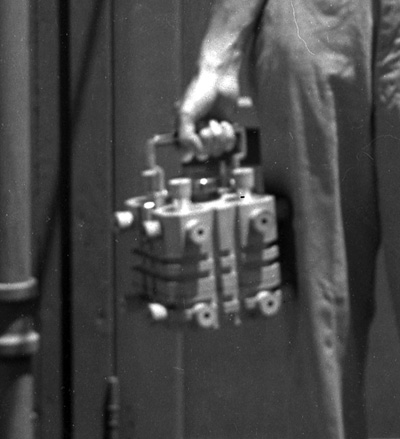
If you haven’t guessed it from the post title alone, that little box is a padded, shielded container that holds the plutonium core for the “Fat Man” bomb that was dropped on Nagasaki. The amount of plutonium in that box was worth about $5 billion dollars in modern money.2 And would kill some 80,000 Japanese.
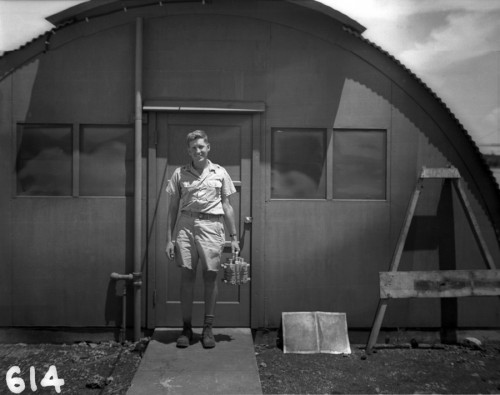
Physicist (and future director of Los Alamos National Laboratory) Harold M. Agnew posing with the Fat Man core
But I guess that’s what one does, right? You’re making history, so you pose with the bomb. Except you can’t really pose with the whole bomb very easily — but you can pose with its little core, a little box of concentrated treasure, death, and, for those who saw it as a possible end to the war (or maybe even all wars), hope. Quite a potent mixture.
- The original source for these are the TR- series of photographs from Los Alamos National Laboratory. These particular files were provided to me by John Coster-Mullen as part of a much larger set of TR- series photos. [↩]
- Stephen I. Schwartz, ed., Atomic Audit: The Costs and Consequences of U.S. Nuclear Weapons Since 1940 (Brookings Institution Press, 1998). See esp. the Brookings Institution page on The Costs of the Manhattan Project. [↩]

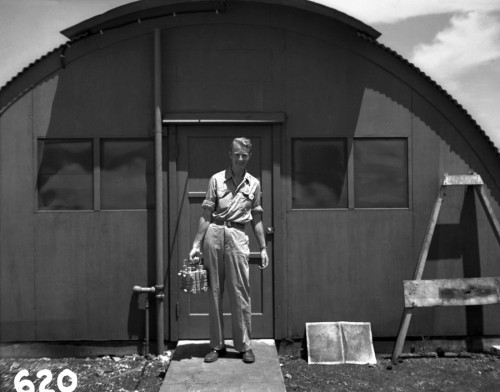
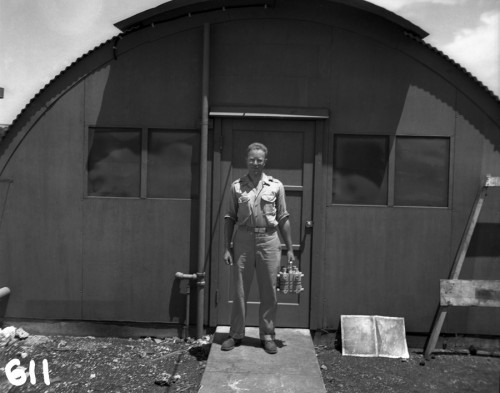
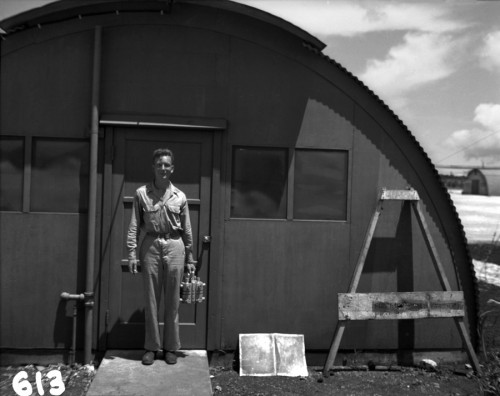



[…] H. Johnston (1918-2011) passed away yesterday as well. Johnston was featured in a previous post as one of the people involved with assembling the atomic bomb on Tinian, and posing with the […]
What strikes me about these photos is the size of the box they’re carrying. It’s rather small, and as you said, it was padded.
This really puts into perspective that you don’t need a heck of a lot of Pu to do a lot of damage — if you know what you’re doing and can use it correctly with the rest of the bomb components.
And just think of how much weapons-grade Pu-239 we have in the world now, not all of it particularly secure, depending on which part of the world you’re talking about.
Thanks for this post. I’m going to wander around your blog a bit; I’m so glad I stumbled across it.
Thanks, Page! Yes, I’m fascinated by how small the box is too. 13 pounds or so is not very much when you’re talking about something as dense and massive as plutonium — a sphere a little over 3 and a half inches in diameter.
Thomas Farrell took the plutonium core, and said it was warm! 😀 I didnt do it!
[…] note this is neither first time, nor probably the last time, that this blog will feature folks taking glamor shots with a weapon of […]
Fat Man lans:
http://www.nytimes.com/slideshow/2008/12/08/science/120908-Bomb_2.html
Pit Assembly:
http://www.flickr.com/photos/conqueror_worm/5081612380/
Gadget:
http://www.flickr.com/photos/conqueror_worm/5081612408/in/photostream/
[…] and no longer features that photograph as prominently as in the past). Agnew was a major figure, present at the bombing of Hiroshima and later a director of Los Alamos. Dolan is mostly recognizable to me (and most others) as half […]
I’m curious as to why the box would be shielded. Is it known that the core was actually shielded in the box? What material was used, presumably to shield against gammas since the alphas are shielded by the plating? One sees many people handling metallic plutonium (your article on Rocky Flats shows such), and Schreiber is quoted as saying he personally handled a great many pits during his career.
There is more detail on the box in question here. It was developed to keep the cores cool and shielded against mechanical damage. It was made out of magnesium, purposefully to help with dissipating heat and to avoid reflecting neutrons into the core.
[…] I wanted to share the results of one little investigation. I’ve posted a few times now (Posing with the plutonium, Little boxes of doom, The Third Core’s Revenge) on the magnesium boxes that were used to […]